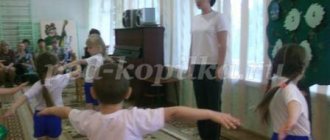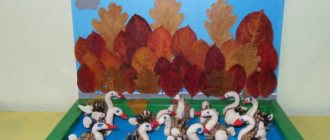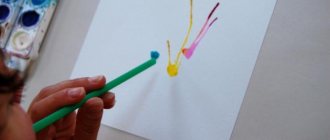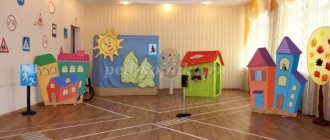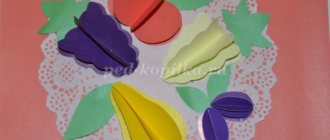Swimming lesson notes for the senior group of kindergarten
Swimming lesson notes for senior groups
Lesson 1-2.
Tasks:
remind children about the rules of behavior in the pool;
introduce them to different methods of swimming - crawl on the front and on the back (show pictures);
to teach you to confidently enter the water and dive headlong.
On the land. Oru No. 1.
In water.
1. Enter the water on your own, catch a floating toy, walk and run with the toy in your hands in different directions, and take a plunge if you wish.
2. Plunge your head into the water together, standing in a circle and holding hands, 3-4 times.
3. Game “Seine” (2-3 min).
4. Show who can swim and how.
Lesson 3-4.
Tasks:
teach children to confidently dive headlong into water;
practice walking forward and backward (chest depth), overcoming the resistance of the water;
teach them to act in an organized manner and not push each other.
On the land. Oru No. 2.
In water.
1. Enter the water on your own, walk along the side without holding the handrail.
2. Holding the handrail, side, squat, plunging headlong into the water, 4-5 times.
3. Walk from side to side back and forth, helping yourself with rowing movements of your hands, 2-3 times. 4. Jump in place, pushing off the water with your hands (“Who’s taller?”), 7-8 times.
5. Run in the water, catching up with each other (“We are funny guys”), 3-4 times.
6. Holding the side of the handrail with your hands, lie down on the water, take a horizontal position (“show your heels”), 2-3 times. 7. Independent games with toys.
Lesson 5-6.
Tasks:
to teach children, upon entering the water, to dive headlong on their own;
practice moving in pairs, holding hands;
cultivate courage.
On the land. Oru No. 3.
In water.
1. Enter the water and plunge yourself headlong.
2. Walk along the side, leaning forward, folding your hands in a boat, 1-2 minutes.
3. Run, at the signal, fall into the water with your arms stretched forward.
4. Walk and run in pairs around the pool, holding hands, 2-3 minutes.
5. Standing, immersion in water up to the chin, up to the eyes, with the head (“Pump”), 6-8 minutes.
6. Game “Angry Fish”, 3-4 times, in pairs facing each other and holding hands, perform alternately.
Lesson 7-8.
Tasks:
continue to teach children not to be afraid to dive into water, not to wipe their faces with their hands after immersing their heads in water, to practice the ability to exhale into the water;
improve the ability to lie on the surface of the water;
activate children's attention.
On the land. Oru No. 4.
In water.
1. Enter the water on your own, walk along the side, helping yourself with your hands, 1-2 minutes.
2. Run slowly and quickly, helping yourself with your hands, fall into the water from a run, plunging headlong, try not to wipe the water from your face, 2-3 minutes.
3. Standing in pairs, take a deep breath, squat down, immersing yourself up to your nose, exhale vigorously, so that there are a lot of bubbles, 3-4 times.
4. Do “Medusa”, 2-3 times.
5. Jump in pairs, moving forward, whose pair will quickly move to the opposite side of the pool, 2-3 times.
6.Standing at the side, holding it with your hands, sit down, jump as high as possible so that your legs come off the bottom of the pool, 4-5 times.
7. Game “Find yourself a partner”, run catching up with each other 2-3 times. 8. Sit down, exhale into the water, 5-6 times.
Lesson 9-10.
Tasks:
continue to teach children to exhale into the water; open their eyes in the water; develop the ability to assume a horizontal body position in the water.
On the land. Oru No. 5.
In water.
1. Enter the water and plunge yourself up to your chin and head.
2. Run, raising your knees high (“Horses”), 2-3 minutes.
3. Standing at the side, holding it with your hands, plunge into the water with your head and quickly jump out, 3-4 times.
4. Standing in a circle, holding hands, take a deep breath, squat, immersing yourself up to your eyes, exhale so that bubbles appear, 3-4 times.
5. Standing in a circle, lower your face into the water, open your eyes 2-3 times. (Look at objects in the water, count your fingers, etc.).
6. Game "Carousel".
7. Lying on the water, holding the side, move your straight legs up and down 3-4 times.
8. Game “Run for the ball” (free play with the ball), 2-3 times.
Lesson 11-12.
Tasks:
continue to develop the ability to take a deep breath and long, full exhalation; prepare for performing chest slides; learn leg movements.
On the land. Oru No. 6.
In water.
1. Enter the water, walk across the pool in a half-squat, leaning your hands on a floating object (board, toy), 1-2 minutes.
2. Make splashes by vigorously clapping your palms in the water.
3. Standing, lean forward slightly, move both hands left and right, as if rinsing clothes. 4. Raise your arms up, inhale, then sit down, clasping your knees with your hands, exhale into the water, 2-3 times.
5. Walk into a hoop lowered into water, plunging your head into the water for 2-3 minutes.
6. Holding the side or handrail, straighten your legs back so that they float up (heels are visible), lower your face into the water 2-3 times.
7. Game “Umka the Bear and the Fishes.”
8. Exhale into the water, 4-6 times.
Lesson 13-14.
Tasks:
teach how to move and navigate under water, lie on the water, master crawl leg movements; cultivate initiative and resourcefulness in children.
On the land. Oru No. 7.
In water.
1. Enter the water, run along the side, helping yourself with rowing movements of your arms, 1-2 minutes. Plunge headlong.
2. Sitting down, exhale into the water 5-6 times.
3. Lie on the water, holding the handrail, practice moving your legs, 1-2 minutes.
4. Walk around the pool, lower your face and exhale into the water, 1-2 minutes.
5. Jump along the bottom from side to side, helping yourself with your hands (“Who’s faster?”), 2-3 times.
6. Dive under a hoop floating on the water 4-5 times.
7.Game “Spiderbug” (2-3 r
Lesson 15-16.
Tasks:
teach children to lie on the surface of the water, move straight or sideways in the water;
familiarize yourself with the movements of the legs in sliding;
practice coordination of actions.
On the land. Oru No. 8.
In water.
1. Enter the water yourself, dive headlong, exhale into the water 4-6 times.
2. Walk one after another, raking the water with your hands, 1-2 minutes.
3. Walk to the right and left with side steps, holding hands, 1-2 minutes. Everyone plunge up to their necks together.
4. Standing in a circle, raise your arms up, take a deep breath, sit down, group yourself, float up (“like a float”), gradually exhale into the water, stand up, straighten up, 3-4 times.
5. Lying on the water, holding on, perform movements with your legs, as in the crawl, 2-3 minutes.
6. Stand in pairs facing each other, holding hands. One should straighten his legs back and move, as in a crawl, the other, pull it, as if in tow, stepping backwards (perform from the middle of the pool to the side). Change roles 3-4 times.7. Game “Crucian carp and pike”, 3-4 times. 8. Try to swim on your own.
Lesson 17-18.
Tasks:
teach children how to slide, continue to strengthen the ability to dive headlong into water, open their eyes, move in the water in different directions without interfering with each other;
Learn to listen carefully to the teacher and act quickly and in an organized manner when given a signal.
On the land. Oru No. 9.
In water.
1.
take a running start and fall into the water, plunging headlong 2-4 times.
2. Standing at the edge, raise your arms up, placing your palms on top of each other (head between your hands), slightly push off from the bottom of the pool, slide through the water towards the other edge, holding your breath, 4-6 times.
3. Standing in pairs, holding hands, alternately squat, immersing yourself in the water with your head and exhaling (“Pump”), 3-4 times.
4. Game “In tow” with leg movements, 3-4 times.
5. Sitting down, lower your face and head into the water, examine objects at the bottom of the pool, 2-3 times, 2-3 times.
6. Exhale into the water, 5-6 times.
7. Game “We are funny guys” (with running, driver-teacher), 3-4 times.
Lesson 19-20.
Tasks:
continue to teach children how to slide on their chest; introduce sliding on your back. Practice exhaling into the water with the body in a horizontal position; cultivate organization.
On the land.
Oru No. 10.
In water.
1. Walk across the pool backwards, raking with your hands, 2-4 times.
2. Move both hands from right to left and vice versa at the surface of the water, making waves with your palms, 6-8 times.
3. Holding onto the side, take a deep breath, sit down, immerse yourself with your head, exhale 5-6 times.
4. Perform a slide, pushing off with one foot from the wall of the pool. Get children to fully straighten (arrow position), 4-5 times.
5. Holding the side, stretch your legs so that they float up, make alternating movements with straight legs up and down. Repeat 3-4 times.
6. Perform back sliding with support, 2-3 times.
7. Game “Round Dance”, 3-4 times.
8. Exhale into the water, 4-6 times.
Lesson 21-22.
Tasks:
consolidate the ability to lie freely on the water and float up; learn to exhale into the water while sliding on your chest; cultivate courage and perseverance.
On the land. Oru No. 11.
In water.
- Enter the water, plunge yourself into the water, 1-2 minutes.
- Run in different directions, raking the water with your hands, at the signal, stand at the side, turn your back to it, 2-3 times.
- While standing, raise your arms forward and up, inhale, hold your breath, lean forward, lie down smoothly on the water, relax, float to the surface of the water, swim like a “jellyfish,” stand up, 2 times.
- From the “jellyfish” position, make a “starfish”, 2 times.
- Repeat “float” 2 times.
- Push off with your feet from the bottom, slide forward, arms forward, exhale into the water (“arrow”).
- Game “Train into the Tunnel! "(walk one after another, diving into a hoop), located vertically, 2-3 times.
- Free swimming, independent water games.
- Exhale into the water, 3-5 times.
Lesson 23-24.
Tasks:
teach children to float up and lie on their back;
Prepare for learning hand movements;
Learn to navigate while moving in the water.
On the land. Oru No. 12.
In water
.
1. Enter the water. Stand by the side with your right side, hold on to it with your right hand, take a breath, immerse your face in the water, hold your breath (count to three), straighten up, exhale. Do the same, holding the handrail with your left hand, repeat 2-3 times.
2. Hold on with both hands, inhale, sit down and plunge headlong into the water, exhale 3-4 times.
3. Repeat the exercise - lying on your chest, 2 times each.
4. Standing in the water up to your waist, arms down, inhale, hold your breath, sit down, slowly lean back, lie on your back in the water, float to the surface of the water, swim and breathe freely, 3-4 times.
5. Perform chest slides across the pool 3-4 times.
6. Game "Wasp".
7. Independent swimming and playing with toys.
Lesson 25-26.
Objectives: to familiarize children with sliding on their chest while exhaling into the water;
Practice movements with straight legs, as in the crawl method;
Develop skills of lying on your back;
Cultivate courage.
On the land. Oru No. 13.
In water.
1. Enter the water. Run in pairs, holding hands, from side to side.
2. Squat in pairs, who will stay under water longer (count) and make more bubbles, 3-4 times.
3.Holding the side with your hands, perform movements with straight legs, as when swimming crawl, 2-3 minutes.
4. Stand with your hands behind your head, sit down and lie on your back, swim in this position 2-3 times.
5. Exhale into the water through the mouth, 5-6 times. 6. Slide on your chest, exhale into the water (for 1-4 counts), 3-4 times. 7. Game “Train into the tunnel!”, 2-3 times. 8. Independent games in the water.
Lesson 27-28.
Objectives: learn to slide on your back;
introduce the movement of the legs while lying on your back, holding onto the side;
teach to act on a signal.
On the land. Oru No. 14.
In water.
- Enter the water. Run in different directions. At the signal, dive headlong; then make a “jellyfish”; then lie on your back; make a “float”. Repeat each movement 2 times.
- Sliding on the chest with exhalation into the water through the mouth (slowly, for 1-4 counts), 6 times.
- Lying on your back, holding onto the side, work with straight legs, as in the crawl.
- Standing in a circle, holding hands, sit down, dive up to your nose and exhale slowly 2-3 times.
- Game “Divers” (get an object from the bottom), 2-3 times.
- Game “We are funny guys”, 2-3 times.
- Run on water in pairs; three each.
Lesson 29-30.
Tasks:
exercise children in sliding (pushing off the wall of the pool);
introduce the combination of inhalation and exhalation into the water in a horizontal position; develop the ability to glide on your back; cultivate independence and courage.
On the land. Oru is 15.
In water.
1. Enter the water yourself and take a plunge.
2. Holding the side with your hands, inhale, immerse your head in the water, exhale 4-6 times.
3.Run in pairs, holding hands, 2-3 minutes.
4. Slide on your chest after pushing off from the wall of the pool, 2-4 times.
5. Holding the handrail or side, lie horizontally, heels visible on the water, inhale, hold your breath, lower your face, exhale (slowly for 1-4 counts), stand up. Repeat 4 times.
6. Slide on your back, arms up (“arrow”).
7. Game “Brave Guys”.
8. Free swimming.
Lesson 31-32.
Tasks:
strengthen the skill of opening eyes in water;
show children sliding with a board or toy in their hands;
teach to exhale into the water while sliding;
develop orientation in water and independence of action.
On the land. Oru No. 16.
In water.
1. Standing in pairs, at a signal, sit down, dive into the water with your eyes open, look at each other, 2-3 times. The same, but with exhalation into the water, 3-4 times.
2. Run around the pool, catching up with your partner, 1-2 minutes.
3. Standing at the side, take the board, slide to the other side at the signal, everyone at the same time, 3-4 times. 4. Slide on your chest, with a board, with an exhalation into the water (push, face into the water, exhale for 1-4 counts), 4-6 times.5. Slide on your back, toy under your head, hold with both hands, 3-4 times. 6. Slide on your chest, in the middle do a turn on your back (“screw”), 2-4 times.
7. Games “Diver”, “Pike”.
Lesson 33-34.
Tasks:
learn leg movements in sliding on the chest with an object in the hands;
Learn to move along the bottom using hand strokes;
teach to help comrades.
On the land. Oru No. 17.
In water.
1. Enter the water, plunge headlong, exhale into the water 2-3 times.
2. At the signal, run across the pool, take a toy, 1-2 minutes (the toys float on the water).
3. Standing at the side, blow on the toy as hard and as long as possible (according to whoever floats further), 3-4 times.
4. Exhale into the water, 3-4 times.
5. Holding the toy in your hands, push off with both feet and slide 2-3 times.
6. The same, but with breath holding (we swim and don’t breathe) (at a signal), 1-2 minutes.
7. Squat and jump out of the water as high as possible, immersing yourself in the water with your head and exhaling in the water, 3-4 times.
8. Standing, bend over, arms extended forward under water, chin in the water, slowly stroke with one hand, then with the other, stepping forward, 10 times.
9. Games “Riding in circles”, “Brave guys”.
Lesson 35-36.
Tasks:
learn the coordinated movement of the legs crawl on the chest with breathing while standing in place;
teach children to slide on their chest with leg movements;
improve the ability to slide on your back and coordinate actions.
On the land. Oru No. 18.
In water.
1. Enter the water, take a plunge at will, and slowly exhale into the water through your mouth 4-6 times.
2. Game "Fountain".
3. Lying in the water, leaning on the side, put your chin on the water, turn your head so that one ear is hidden under the water, inhale in this position, turn your head and immerse your face in the water, exhale 2-3 times.
4. Combine the actions of inhalation and exhalation with crawl leg movements (count 1-4), 3-4 times.
5.Slide after pushing off against the wall of the pool on your back, stretching your arms up 5-6 times.
6. Standing, lean forward, do arm strokes, 6-8 times.
7. In the same starting position, rest your hands on your knees, chin in the water, inhale, lower your face into the water, exhale, 2-4 times.
8. Improve the movement of the legs in sliding on the chest, 1-2 min.
9. Game “The sea is agitated.”
10. Free swimming.
Lesson 37-38.
Tasks:
teach children to swim on their chest, with an object in their hands using leg movements;
practice sliding on your back; develop agility, courage and orientation in the water.
On the land. Oru No. 19.
In water.
1. Having entered the water, dive and “catch” a small hoop or circle floating on the surface on your head 2-3 times.
2. Standing facing the side, hands down, lie freely on the water, on your back, keep your hands at your hips, push off with your feet, slide 5-6 times.
3. Lying on your chest, hold the handrail or side with your hands, perform leg movements, combining them with breathing, 1 min.
4. Try to sit on the bottom of the pool.
5. Game “Brave Guys”.
6. Swim on your chest using leg movements with an object in your hands, 2 min.
7. Repeat exercises 5 and 6 (with head rotation) from lesson 18.
8. Game “Train into the tunnel! " 9. Free swimming.
Lesson 39-40.
Tasks:
introduce children to exercises in sliding on the chest with leg movements combined with exhalation and inhalation;
teach gliding with rowing movements of the hands;
On the land. Oru is 20.
In water.
1. Float and lie on the water by choice.
2. Game “Mirror” in pairs.
3. Standing, raise your arms up, join your palms (take the “arrow” position), push off with both legs, slide on your chest to the opposite side of the pool, slide back on your back, 3-4 times.
4. Slide on your chest using leg movements after pushing off from the side, combining exhalation into the water and inhalation (turn your head to the side), 2-3 times.
5. Game "divers".
6. Swim on your chest using leg movements with a board in your hands, 1-2 minutes.
7. Swim on your back using leg movements with the board behind your head, 1-2 min.
8. Slide on your chest and back with rowing movements of your arms.
9. Exhale into the water, 5-6 times.
10. Free swimming.
12
Organizing and conducting a swimming lesson[edit | edit code]
From a pedagogical point of view, the most appropriate and basic form of organizing classes is considered to be lesson-based, which has proven itself in long-term practice. During the lesson, interactions between the teacher and students are based on direct contact. This allows the teacher to timely monitor and direct the cognitive motor activity of all students.
The educational process in the classroom is considered as a system of continuous interactions between the teacher and a constant group of students.
The main benefits of the lessons are as follows:
- continuity and clarity of organization and management of the educational process;
- close contacts and the opportunity for the teacher to better study the students, and the students to study each other;
- the stimulating influence of an organized team on everyone.
Lesson
- a form of organization of training that provides active and systematic educational and cognitive activity aimed at solving the assigned tasks. The main feature of the lessons is the teacher’s guidance, for a precisely set time, in a specially designated place, of collective motor activity of a relatively homogeneous group of students, taking into account their characteristics and individual capabilities. The lesson form of swimming lessons involves a teacher guiding the process of learning, improvement, and training, which takes a certain amount of time and is organized in a special location. The quality of the lesson depends on the teacher’s preparation for the lesson, the organization of students’ activities during the lesson, and ways to increase its effectiveness. The lesson includes content, has a structure, organizational support, contains requirements for the content and methodology, implies the preparation of the teacher and the implementation of pedagogical control in the lesson.
Swimming lessons are classified as follows:
- by target area (physical training lessons, specialized swimming training, sports training, applied swimming, exercise therapy, etc.);
- according to the content of educational orientation (with selective educational orientation, with multilateral influence, control);
- according to the program content of classes (subject-specific and complex);
- with a hygienic focus (general developmental and compensatory, restorative);
- according to the content of the educational focus (introductory lessons for learning new material, improvement lessons, control and mixed lessons; combined lessons (methodological)).
There are four sides to the lesson content.
1. Objectives and composition of physical exercises (educational material). The content is determined by tasks that reflect the subject and focus of the classes, the nature of the activities of the teacher and students, as well as projected (expected) changes in the state of the body, knowledge, skills, qualities and behavior of students. Usually the entire content of the lesson is reduced to just a set of physical exercises. However, they constitute only the substantive content of the lesson and should be considered as one of its important aspects.
2. Activities of the teacher. In a lesson, teacher and student always interact.
3. Activities of students in connection with performing physical exercises (listening to the teacher, observing what is shown, comprehending what is perceived, designing and performing given motor actions, self-control and self-esteem, mutual control and mutual evaluation, mutual assistance, discussion of emerging issues, etc.).
4. Physiological and mental processes, representing the internal side of the activities of those involved, lead to the desired changes in the state of their body, knowledge, skills, qualities and behavior.
All aspects of the content of a swimming lesson are interconnected and interdependent. It is up to the teacher to ensure such consistency between the various aspects of the content that would lead to high effectiveness of the lesson. This is achieved by correctly constructing the lesson and organizing its structure.
In order for a lesson to receive a complete, harmonious expression, its diverse content must be organized, ordered in time and put into the necessary form.
Lesson structure
- this is the ordering of all aspects and components of the lesson content, taking into account the laws of physical education, available time resources and working conditions.
In swimming, a lesson structure is used, consisting of three parts - introductory (preparatory), main and final.
Introductory (preparatory) part
lesson performs a service function, since it only ensures the creation of prerequisites for the main educational work. Typical tasks of the preparatory part are as follows:
- organize students;
- activate their attention;
- familiarize students with the intended content of the lesson;
- create an appropriate psychological attitude and positive emotional state;
- prepare the body of those involved for the upcoming loads.
This part includes: organization of those involved (construction, calculation, report, marking those present, etc.); a brief repetition of what has been covered with an analysis of general and individual mistakes; preliminary explanation and demonstration of new educational material.
One of the goals of the preparatory part of the lesson is the development of motor skills. This is achieved through exercises that do not require a long time for preparation and execution, and are easily dosed. These include walking, running, and general developmental exercises aimed at preparing the body of students to more successfully perform the exercises of the main part of the lesson.
The peculiarity of the preparatory part of a swimming lesson is that in addition to organizing students and preparing them for the main part of the lesson, it includes showing and performing simulation exercises so that students clearly understand these movements even before entering the water, performing previously learned and new auxiliary exercises.
After the preparatory part of the lesson, before entering the water, a roll call is required.
Main part
lesson performs the main function, since it is in it that all categories of physical education tasks are solved (educational, physical development). These include the following tasks:
- develop knowledge in the field of motor activity;
- teach motor skills of a general educational, applied and sports nature;
- develop general and special functions of the musculoskeletal system, cardiovascular and respiratory systems; form and maintain good posture; harden the body;
- cultivate moral, intellectual, volitional and aesthetic qualities.
In the main part, the main objectives of the lesson are solved, aimed at mastering the technique of sports swimming, developing and improving the motor qualities of those involved. This part includes: exercises for studying and mastering technical elements of swimming methods and their coordination, techniques for starts and turns, exercises for improving the technique of the method of swimming being studied, as well as games and entertainment in the water that increase the emotional state of those involved.
In the final part
The lesson provides for a gradual reduction in the load and an increase in the emotionality of the lessons.
Typical objectives for the third part of the lesson are as follows:
- bring the body and psyche of those involved into an optimal functional state; maintain correct posture;
- summarize the educational activities;
- introduce students to the general content of the next lesson so that they can independently perform some exercises, etc.
Usually in the final part of the lesson there are games, relay races, diving, diving, free swimming, doing exercises you like, etc.
At the end of practical exercises in the water, the students exit the water in an organized manner, line up, count out in order, the trainer makes brief comments and instructions on the quality of the exercises performed by those involved in this lesson and individual comments that have educational value. He gives general and individual tasks for self-study at home.
The main feature of a swimming lesson is that the preparatory part is carried out mainly on land and partly in the water, the main part is completely in the water, the final part is in the water, then on land.
Non-classroom forms of organizing classes differ in focus, objectives, content and structure, composition of students, regularity of attendance, time and conditions, leadership (independent or under the guidance of a teacher). Their peculiarity is a simplified structure; the activity requires initiative, independence, interest, and inclination.
The main objectives of active recreation are to strengthen or restore health, maintain or restore performance, and develop motor skills. Depending on the number of students, individual, group and mass forms of classes are distinguished, which in terms of frequency can be regular or episodic.
In the first swimming lessons, explaining and correcting errors when performing simulation exercises takes more time than in subsequent lessons, so the preparatory part can be quite long (up to 30 minutes).
If classes are held in an open reservoir and the water temperature is low (18 - 20 ° C), the duration of stay in the water is reduced; Due to this, you can increase the duration of training on land. In cool weather, the motor density of the preparation part should be higher.
During swimming lessons, the teacher should be in a place where he can clearly see the whole group and everyone involved, and those in the water can see him. When improving swimming technique, the teacher should observe students from various places in the pool: in front, on the side, behind and, if possible, even from above (usually from the springboard).
At the end of classes on open water bodies, it is necessary to quickly conduct a roll call of students; after this, give them the opportunity to do light gymnastic exercises, dry themselves and get dressed.
When summing up the lesson, the group’s successes and mistakes that need to be corrected in the future are noted.
